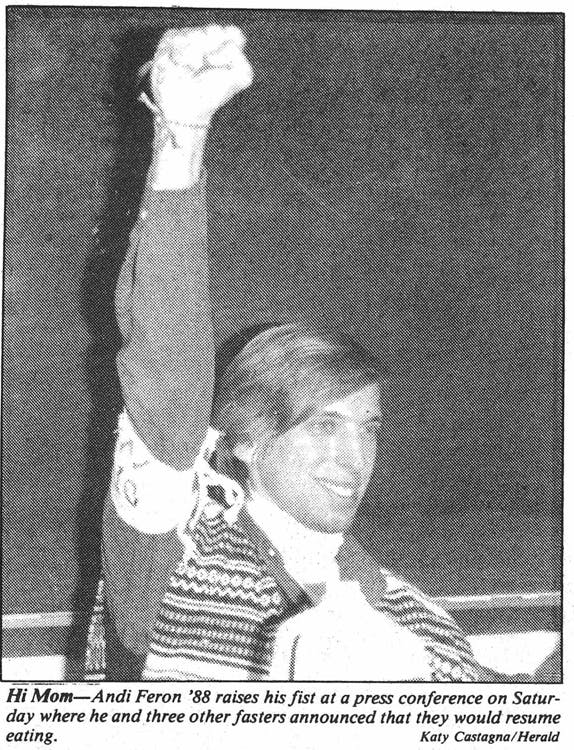The University has a long history of student activism. Over the years, activism at Brown has taken the form of walkouts, sit-ins and campus building occupations.
On Wednesday, 20 members of the advocacy group BrownU Jews for Ceasefire Now were arrested for trespassing after occupying University Hall as part of their demands that President Christina Paxson P’19 P’MD’20 publicly commit to “include and support a divestment resolution in the next meeting of the Brown Corporation,” The Herald previously reported.
The Herald went back through its archives to explore past student demonstrations and sit-ins at Brown.

In 1968, 65 African American students held a walkout to protest the University’s failure to increase Black student enrollment and financial support, The Herald reported at the time.
The students marched “double-file from Faunce House to the Congdon Street Baptist Church,” a Herald reporter wrote.
After three days, then-President Ray Heffner agreed to increase the percentage of Black women admitted to the University to 12.5% — at the time, women attended Pembroke College. He also agreed to designate $1.2 million to scholarship and recruitment efforts over three years to raise the overall percentage of Black students enrolled, according to Brown’s library.

In 1975, 40 students from the Third World Coalition occupied University Hall for 38 hours to protest the University’s limited matriculation and recruitment of non-white students and faculty. The occupation, which was partially motivated by what students believed was the University’s lack of seeing through its commitments following the 1968 walkout, coincided with the deadline by which TWC demanded that the University commit to increasing its recruitment of people of color.
The protest eventually culminated in negotiations and a finalized agreement, which included a commitment from Brown to “strive for a 25 percent increase over the next three years in the number of Black (and Latinx) students applying and gaining admission to the University.”

In 1985, 50 student protestors occupied the John Carter Brown Library for three hours, after about 150 students engaged in a sit-in at the admissions office.
The University obtained a restraining order demanding the students leave by 5:00 p.m., but the protestors reached an agreement with administrators prior to the deadline. The agreement included requests for the University to create a “task force to look into establishing a new Third World Center” and investigate “Director of Police and Security John Kuprevich’s decision to hire plainclothes officers to watch the Third World Center,” The Herald reported at the time.
The agreement also committed to implementing a “student/faculty committee to examine Brown security’s treatment of minority students,” The Herald wrote, adding that the agreement did not address most of the original demands for “more minority faculty, admissions, financial aid, support services and a less Eurocentric curriculum.”

In 1986, four students began a fast in Manning Chapel in a call for the University to divest from South Africa during its apartheid regime. The University disenrolled the students, prompting them to end their fast. They were then reenrolled.
The following year, 23 students were placed on probation after the campus group Students Against Apartheid disrupted a Corporation meeting to demand total divestment.

In 1992, Students for Aid and Minority Admission occupied University Hall, calling on the University to partake in need-blind admissions.
“Within minutes, all three floors (of University Hall) had been occupied, official business had ground to a halt and need-blind banners were draped out of upper-story windows of the” building, The Herald reported.
253 students were arrested and charged with five criminal counts: “disturbing a public assembly general, disorderly conduct, two counts of willful trespassing … and prevention from carrying on employment,” The Herald reported. The students disputed their charges and “ultimately had to pay a fine to the University,” according to the Brown Library.
The fall of 2013 was wrought with protests before a scheduled lecture by then-New York City Police Department Commissioner Raymond Kelly, due to his support of “stop-and-frisk” policing, The Herald reported.
Protestors gathered outside List Art Center during the talk and, when it began, attendees booed, “stood with their fists in the air and began shouting in unison,” prompting administrators to cancel the lecture after about half an hour.
Community members addressed the protest over the following months through faculty and student discussions, teach-ins, the creation of a committee and the publication of two reports about the events that unfolded.
In 2015, The Herald reported that students of color occupied the rotunda outside of Paxson’s office during her office hours after the administration released a draft of its diversity and inclusion action plan. Though Paxson didn’t engage with the students present, she told them they were “doing nothing wrong,” and would “have amnesty for this action.”

Katie Jain is a University News editor from New Jersey overseeing the graduate student life beat. She is a senior concentrating in International and Public Affairs and History.





